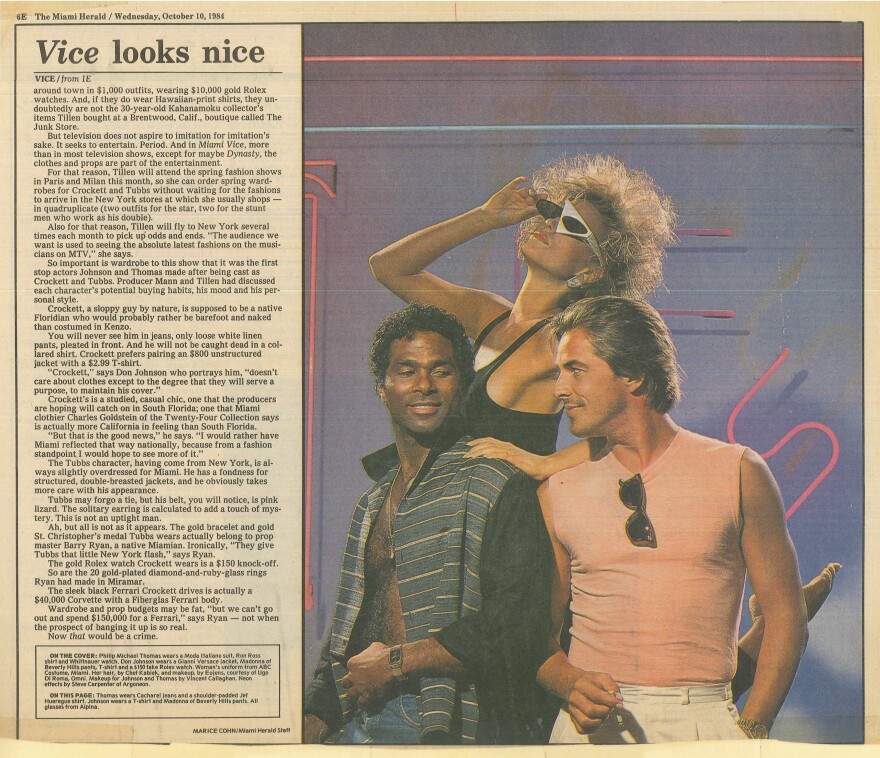In the 1980s, Miami was a crime capital. Dade County -- that’s what it was called then -- had the highest murder rate in the country, and nearly three quarters of all the cocaine and marijuana that made it into the U.S. passed through South Florida.
These disturbing statistics were reported in a now iconic Time magazine cover story headlined, “Paradise Lost.” The tale of Miami as a so-very-dangerous-town was there for a national audience to consume. It captivated many a journalist too. International reporters visited Miami to capture the intrigue of city now known for strip-mall drug deals.
Around that time, a television show came to town, inspired by the wild crime reports. The show’s creator, Anthony Yerkovich, believed the reality of Miami would make for compelling television.
Yerkovich wrote the pilot, a two-hour movie that aired on NBC Sept. 16, 1984. It was TV with pretty colors and moody music – a cops-and-robbers drama shot MTV-style. Plenty of local leaders thought the show would ruin Miami’s reputation. One of the show’s leads, actor Don Johnson, understood why.
Here’s what Johnson said on NBC’s Today show about local leadership raising its eyebrows over the show: “I think they were, rightfully so, concerned about what we were about to bestow upon them with a show called Miami Vice.”
By the time the show was in summer reruns after season one, its popularity had exploded. Miami Vice put bikini-clad women, muscle-bound guys and hot cars on what was actually an desolate, even crime ridden South Miami Beach.
Lori Wyman, who was born and raised in Miami Beach, cast four seasons of Miami Vice. She said she was contacted by an international pool, anxious to get parts as extras. Wyman also swears actual drug dealers auditioned for roles. While she thought they were scary at first, she realized they were just as intimidated by her.
“They were more afraid of me because I was the casting director,” said Wyman.
University of Miami alum Saundra Santiago played Detective Gina Calabrese on the show. Santiago had just moved to New York when she was cast. She’d been anxious to move to the big city but returned to Miami to get one of her first major roles as an actresss. She said fame was a drug for the cast. Philip Michael Thomas got loads of attention and Don Johnson was approached relentlessly by female fans. Santiago – who ended up in a few steamy scenes with Johnson -- knew why, describing in detail why he was such a great kisser.
“He obviously had very large luscious lips so it was very easy,” said Santiago.
While Miami Vice looked different because it showcased pastel-colored-suits-and-no-socks fashion, it also sounded different. Howard Cohen was the Miami Herald’s music critic for years. He rocked the turquoise tees and cream-colored pants while car-dancing to songs like Phil Collins' "In the Air Tonight." Cohen said at the time, the way producers used music in the show was considered revolutionary. It was one of the first network dramas to have its own soundtrack.
The look of the show also celebrated Miami architecture. The opening credits featured the Atlantis, a building designed by Coconut Grove firm Arquitectonica. Producers also shot an entire episode at the Pink House, a Miami Shores home designed by firm principal Bernardo Fort-Brescia. There was even a time when Fort-Brescia and Johnson talked about designing a house for the star, but by the time they got serious about plans, the show was cancelled.
Like the firm, the city got incredible exposure, benefiting the local film and tourism industries. The show inspired other directors to bring productions and jobs to Miami. When tourists visited, they asked to see Vice sights and of course, Miami Beach owes the restoration of its art deco buildings, in part, to the Vice spotlight.
The casting director calls the show a 47-minute commercial for the city. Back then, star Philip Michael Thomas said the show simply transcended everything.
“It’s become Miami Nice. You know, everyone wants a little piece of heaven here.”
http://www.youtube.com/watch?v=8KNaXforoks
Read the Miami Herald's Miami Vice retrospective, and all coverage, at MiamiHerald.com.






